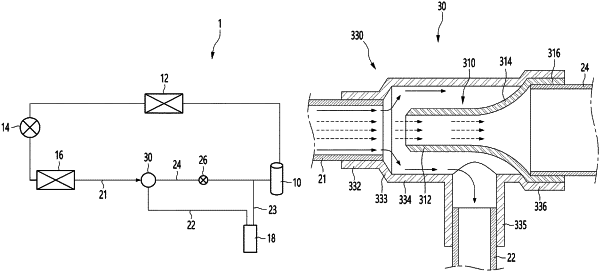| CPC F25B 43/006 (2013.01) [F25B 41/40 (2021.01); F25B 2400/04 (2013.01); F25B 2400/23 (2013.01); F25B 2500/26 (2013.01); F25B 2600/2501 (2013.01)] | 12 Claims |

|
1. A device having a refrigerant cycle, the device comprising:
a compressor configured to compress a refrigerant;
a condenser configured to condense the refrigerant compressed by the compressor;
an expander configured to expand the refrigerant condensed by the condenser;
an evaporator configured to evaporate the refrigerant expanded by the expander;
a separation device connected to an outlet pipe of the evaporator to separate liquid refrigerant and a first portion of gaseous refrigerant from the refrigerant discharged from the evaporator;
a bypass pipe configured to guide the first portion gaseous refrigerant separated from the liquid refrigerant by the separation device to the compressor;
a first refrigerant pipe connected to the separation device and through which the liquid refrigerant discharged from the separation device flows;
an accumulator connected to the first refrigerant pipe to separate a second portion of gaseous refrigerant, which is not separated from the liquid refrigerant by the separation device, from the liquid refrigerant and discharge the second portion of gaseous refrigerant; and
a second refrigerant pipe configured to guide the second portion of gaseous refrigerant discharged from the accumulator to the compressor, wherein the separation device includes:
a first pipe connected to the outlet pipe of the evaporator and extending from an upper side to a lower side;
a second pipe bent from the first pipe; and
a third pipe that extends from the second pipe in a horizontal direction and connected to the accumulator, and wherein at least a portion of the bypass pipe extends upward from the third pipe.
|